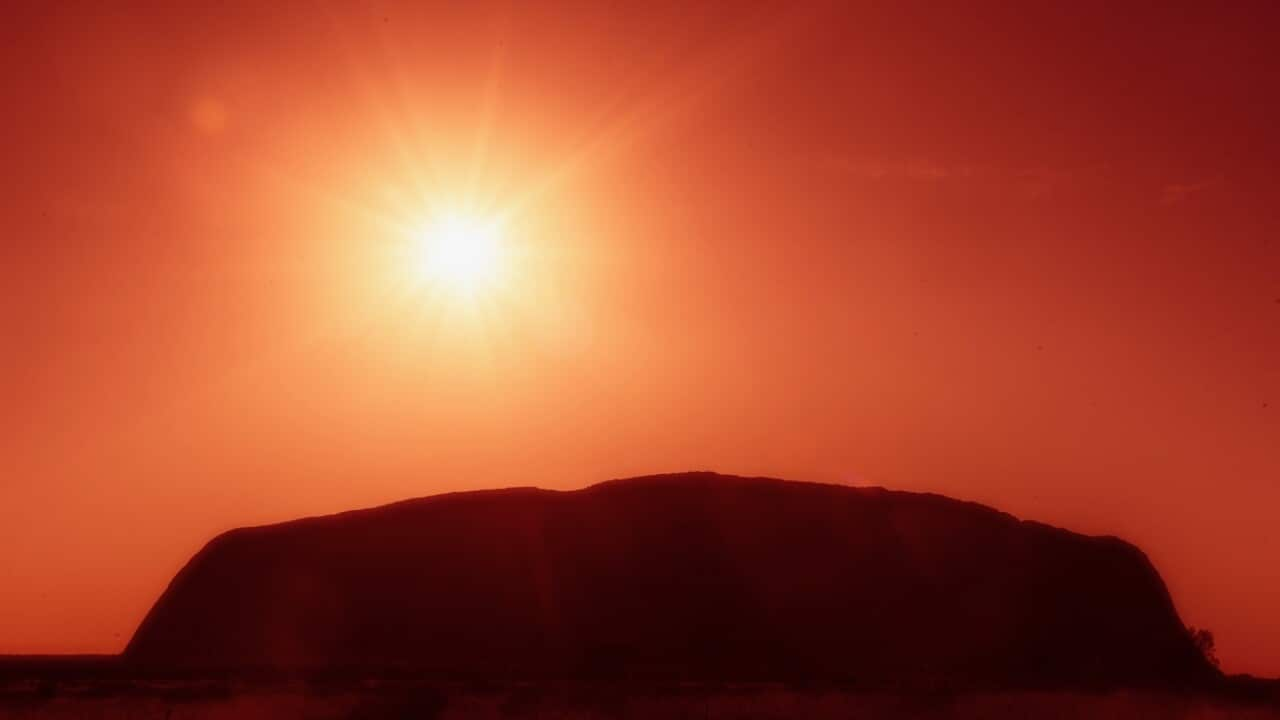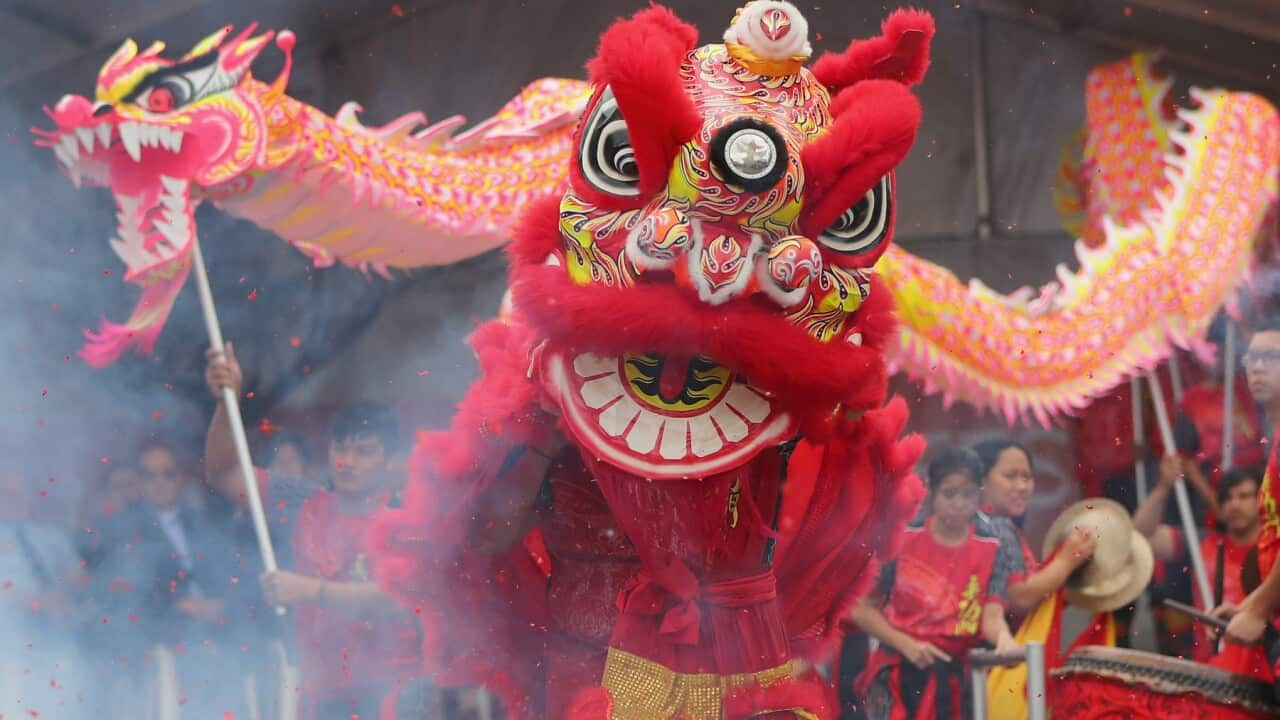250 delegates from 13 Regional Dialogues
On 26 May 2017, at a gathering near Uluru, the was issued to the Australian people.
It contained three reforms from 13 Regional Dialogues, endorsed by the National Constitutional Convention, that was attended by 250 Aboriginal and Torres Strait Islander leaders, as documented in the .
Participation in the regional dialogues that led to the Uluru Statement from the Heart was by invitation from local Indigenous organisations, mostly land councils, who selected the participants.
The Referendum Council sought an invitation list to prioritise the participation of traditional owners.
Roughly, 60 percent of places were to be reserved for First Nations/Traditional Owner groups; 20 percent of places for Aboriginal community organisations; and 20 percent of places for individuals such as activists, Elders, youth, members from the Stolen Generations, and significant figures.
The Uluru Statement proposes three elements: "Voice, Treaty, Truth"
Voice is a short way of referring to a constitutionally enshrined Voice to the Parliament. This means the creation of a body that would advise the Parliament and government on legislation and policy areas that affect Aboriginal and Torres Strait Islander peoples. The Constitutional referendum would amend the Constitution to authorise the Parliament to make a law guaranteeing a First Nations voice to Parliament.
Treaty or Makarrata. Makarrata is a word from the language of the Yolngu people in Arnhem Land. Since the 1980’s it has commonly been used to refer to “treaty”; it means coming together to heal wounds of the past. In practice, a “Makarrata/Treaty commission” would supervise an agreement-making between First Nations and the Australian governments at a national and regional level.
Truth refers to “Truth-telling” as another function of the Makarrata Commission, to tell the truth about the Aboriginal side of Australian history and to bring awareness about the impact of colonisation and dispossession. The Commission would capture these stories as well as stories of co-existence, to create a path for reconciliation between First Nations and Australians.
An example of truth-telling can be found on page fourteen of the Referendum Council’s report from Ross River:
“Participants expressed disgust about a statue of John McDouall Stuart being erected in Alice Springs following the 150th anniversary of his successful attempt to reach the Top End. This expedition led to the opening up of the ‘South Australian frontier’ which lead to massacres as the telegraph line was established and white settlers moved into the region. People feel sad whenever they see the statue; its presence and the fact that Stuart is holding a gun is disrespectful to the Aboriginal community who are descendants of the families slaughtered during the massacres throughout central Australia.”
The Consultation Process
The consultation process started in 2015 when the Prime Minister of Australia established a Referendum Council to oversee a deliberative process that was First Nations designed and led.
More than 1200 Indigenous leaders representing 13 First Nations Regional Dialogues across the country were part of the process:
- Hobart, hosted by Tasmanian Aboriginal Corporation (9–11 December 2016);
- Broome, hosted by the Kimberley Land Council (10–12 February 2017);
- Dubbo, hosted by the New South Wales Aboriginal Land Council (17–19 February 2017);
- Darwin, hosted by the Northern Land Council (22–24 February 2017);
- Perth, hosted by the South West Aboriginal Land and Sea Council (3–5 March 2017);
- Sydney, hosted by the New South Wales Aboriginal Land Council (10–12 March 2017);
- Melbourne, hosted by the Federation of Victorian Traditional Owners Corporation (17–19 March 2017);
- Cairns, hosted by the North Queensland Land Council (24–27 March 2017);
- Ross River, hosted by the Central Land Council (31 March – 2 April 2017);
- Adelaide, hosted by the Aboriginal Legal Rights Movement Inc (7–9 April 2017);
- Brisbane, (21–23 April 2017);
- Thursday Island, hosted by Torres Shire Council and a number of Torres Strait regional organisations (5–7 May 2017).
- The 13th dialogue refers to a truncated dialogue session hosted by the United Ngunnawal Elders Council in Canberra on 10 May 2017.
The Referendum Council sought the approval of the Prime Minister and the Opposition Leader to base the dialogues on the six reform proposals below and ask the dialogues: What is meaningful recognition to you?
- A symbolic statement of recognition.
- Deletion of section 25 of the Constitution (section 25 says that if a State law disqualifies all the people of any race from voting in State elections, then those persons shall not be counted when working out how many seats each state gets in the House of Representatives. The deletion is symbolic as it’s inoperative at the moment).
- Deletion and replacement or moderation of section 51 (xxvi), the race power.
- A racial non-discrimination clause.
- A constitutionally enshrined Voice to the Parliament.
- Agreement-making.
What relevant documents and commissions preceded and followed the Uluru Statement from The Heart?
- The 2018 Joint Select Committee on Constitutional Recognition relating to Aboriginal and Torres Strait Islander Peoples was created to examine the Referendum Council’s work.
It concluded that the Statement from the Heart and the Referendum Council were a turning point in the debate:
“Not only did it bring a new element, The Voice, into the debate but it rejected much that had gone before in terms of proposals for constitutional recognition … At the centre of the Statement from the Heart is The Voice. The Voice is the matter on which we have focused most of the efforts of this Committee” (page viii).
The Joint Select Committee also made four recommendations to the Australian government:
1. To initiate a process of co-design of The Voice with Aboriginal and Torres Strait Islander peoples.
2. To consider, legislative, executive and constitutional options to establish The Voice.
3. To support the process of truth-telling
4. To consider the establishment, in Canberra, of a National Resting Place, for Aboriginal and Torres Strait Islander remains which could be a place of commemoration, healing and reflection.
- The 2017 Referendum Council Final Report sets out the Uluru reforms and the reasons for the change from the Expert Panel recommendations to Voice, Treaty and Truth.
It is a relevant document to know more about the consultation process behind the Uluru Statement from the Heart and understand the practical actions proposed by First Nations peoples to move forward towards Constitutional recognition.
The report also contains ‘Ten Guiding Principles’ that helped the decision-making on the reforms developed by Indigenous communities themselves:
- Does not diminish Aboriginal sovereignty and Torres Strait Islander sovereignty
- Involves substantive, structural reform
- Advances self-determination and the standards established under the United Nations Declaration on the Rights of Indigenous Peoples
- Recognises the status and rights of First Nations
- Tells the truth of history
- Does not foreclose on future advancement
- Does not waste the opportunity of reform
- Provides a mechanism for First Nations agreement-making
- Has the support of First Nations
- Does not interfere with current and future legal arrangements
- On 6 July 2015, the Kirribilli Statement was issued by forty senior Indigenous leaders after meeting with the Prime Minister and the Opposition Leader to ask for a new process of consultation of Indigenous communities. The leaders declared they wouldn’t support a symbolic referendum and issued the ‘Kirribilli Statement’ stating that:
“any reform must involve substantive changes to the Australian Constitution. It must lay the foundation for the fair treatment of Aboriginal and Torres Strait Islander peoples into the future. A minimalist approach, that provides preambular recognition, removes section 25 and moderates the races power [section 51(xxvi)], does not go far enough and would not be acceptable to Aboriginal and Torres Strait Islander peoples.”
- Between 2013 and 2015 the Joint Select Committee on Constitutional Recognition of Aboriginal and Torres Strait Islander Peoples worked to deliver 3 reports, an interim report, a progress report, and a final report.
This Committee’s purpose was to examine the Expert Panel recommendations. In its , it recommended that a referendum be held on the matter of recognising Aboriginal and Torres Strait Islander peoples in the Australian Constitution and that it be held at a time when it has the highest chance of success.
“The committee has considered mechanisms for engagement and recommends that conventions consisting of Aboriginal and Torres Strait Islander delegates as well as delegates from the broader Australian community be held to build support for a referendum and to engage a wide cross-section of the community. The committee recommends that section 25 of the Constitution be repealed, and that section 51 (xxvi) be replaced, with the retention of a person’s power so that the Commonwealth government may legislate for Aboriginal and Torres Strait Islander peoples as per the 1967 referendum result.”
The committee also recommended amending the Human Rights (Parliamentary Scrutiny) Act 2011 to include scrutiny of the United Nations Declaration on the Rights of Indigenous Peoples to act as an enhancement to the existing parliamentary scrutiny framework.
- In 2014, , observed the issues that would need to be confronted when settling on a final model of constitutional recognition that will need to be substantial, not only symbolic.
It said that the broader population also wants to know that the final proposal is one that is wanted by the majority of Aboriginal and Torres Strait Islander Australians before they will give their support to it.
- On 28 March 2013, the came into effect.
The Act - that ceased in 2018 - recognises that the continent and the islands now known as Australia were first occupied by Aboriginal and Torres Strait Islander peoples, and the Parliament, on behalf of the people of Australia, acknowledges and respects the continuing cultures, languages and heritage of Aboriginal and Torres Strait Islander peoples.
- In 2012, the Final Report of the Expert Panel on Recognising Aboriginal and Torres Strait Islander peoples in the Constitution provided recommendations related to: a) forms of recognition, b) race provisions, and c) approaches to the referendum.
This ‘Expert Panel’ chose the reforms to consult on themselves. Its work revealed a limited understanding among Australians generally of the country’s constitutional history, especially in relation to the exclusion of Indigenous peoples from full citizenship, and many were surprised or embarrassed to learn that the Constitution still permits the Commonwealth Parliament to make laws that discriminate on the basis of race not only positively but also negatively.
Previously
- 2008 House of Representatives Standing Committee on Legal and Constitutional Affairs.
- 2003 Senate Legal and Constitutional Affairs Committee
- 2000 Council for Aboriginal Reconciliation
- 1998 Constitutional Convention
- 1992–95 - Post-Mabo Social Justice Package
- 1988 - Constitutional Commission
- 1983 - Senate Standing Committee on Constitutional and Legal Affairs
What key moments in history preceded the Uluru Statement from The Heart?
- 1937 - Yorta Yorta elder William Cooper collected 1800 signatures to petition King George VI for Aboriginal representation in the federal Parliament.
- 1938 - The Aboriginal Progressive Association holds a "Day of Mourning" in Sydney to protest the "callous" treatment of Aboriginal Australians and demand full citizen status and equality.
- 1958 - Aboriginal lobby groups form the Federal Council for Aboriginal Advancement, start a 10-year campaign to change the constitution.
- 1962- Indigenous peoples gain the vote in Commonwealth elections.
- 1963 - The Yirrkala Bark Petitions, a series of petitions from the Yolngu people to the Commonwealth government, asserted that the Yolngu people owned the land and protested the Commonwealth's granting of mining rights to Nabalco of land excised from the Arnhem Aboriginal Land reserve.
- 1965 - Aboriginal or (Arrente and Kalkadoon) student Charles Perkins leads freedom rides through towns in north-western NSW to expose discrimination against Aboriginal peoples.
- 1967 – More than 90 percent of Australians vote "yes" in a referendum that allows the federal government to make laws for Aboriginal people and enables their inclusion in the national census.
- 1972 - The Aboriginal Tent Embassy in Canberra begins in protest against the Liberal party's policy on land rights.
- 1972 – 1000 Aboriginal people sign the Larrakia Petition calling for land rights, and it is posted to Queen Elizabeth.
- 1979 - The National Aboriginal Conference, established in 1973, resolves a treaty that should be made between the government and Indigenous peoples. The word "Makarrata" is used for the first time.
- 1988 - A 1.2-metre-square sheet of wood with the Barunga Statement, the aspirations of Indigenous Australians, is presented to PM Bob Hawke, who called to negotiate a treaty.
- 1990 – Creation of the Aboriginal and Torres Strait Islander Commission (ATSIC) to represent Indigenous peoples and its members are chosen by Indigenous peoples.
- 1991 – Report of the Royal Commission into Aboriginal Deaths in Custody. It recommends a formal process of reconciliation between Indigenous and non-Indigenous Australia.
- 1992 - The High Court's Mabo decision rejects 'terra nullius' and recognises the existence of native title.
- 1995 – The report of the Aboriginal and Torres Strait Islander Commission (ATSIC) says constitutional reform is a priority.
- 1999 - Prime Minister John Howard put to the Australian people a preamble to the constitution that included recognition of Aboriginal and Torres Strait Islander Peoples, without consulting them, and hence rejected.
- 2000 - A gathering of Indigenous people present prime minister John Howard and the Governor-General with a " 250,000 people cross the Sydney Harbour Bridge to support the “Roadmap for Reconciliation" a document a gathering of Indigenous peoples presented to then-Prime Minister John Howard.
- 2005 - ATSIC is abolished following corruption investigations.
- 2007 - PM Howard committed to holding a referendum to recognise Indigenous Peoples in the first hundred days of what would have been his fifth term in office, but he lost the federal election to Labor’s Kevin Rudd.
- 2008 - Labor Prime minister Kevin Rudd says "Sorry" to the Stolen Generations.
- 2008 – Yolngu and Bininj Leaders’ Statement of Intent.
- 2010 - Prime minister Julia Gillard announces referendum plans for the constitutional acknowledgment of Indigenous Australians.
- 2012 – Expert Panel on the Recognition of Aboriginal and Torres Strait Islander peoples in the Australian Constitution hands its report to the Prime Minister.
- 2013 - The Aboriginal and Torres Strait Islander Peoples Recognition Act received Royal Assent on 27 March 2013 and came into effect on 28 March 2013.
- 2013 - Joint Select Committee on Constitutional Recognition of Aboriginal and Torres Strait Islander Peoples established.
- 2014 - Final Report of the Aboriginal and Torres Strait Islander Act of Recognition Review Panel (Anderson Review).
- 2014 - Joint Select Committee on Constitutional Recognition of Aboriginal and Torres Strait Islander Peoples Interim report (15 July 2014) and Progress Report (October 2014).
- 2015 - Joint Select Committee on Constitutional Recognition of Aboriginal and Torres Strait Islander Peoples Final report (31 January 2015).
- 2015 – Forty Indigenous leaders meet with Prime Minister Abbott and Opposition Leader Bill Shorten at Kirribilli House to request a new process to consult Indigenous communities. Indigenous leaders issue the Kirribilli Statement stating symbolism and minimalist reform will not be acceptable.
- 2015 - The Referendum Council is appointed by Prime Minister Malcolm Turnbull and Labor leader Bill Shorten to start walking towards a referendum.
- 2017 – May 26th, 2017 Uluru Statement from the Heart issued to the Australian people.
- 2017 – Referendum Council hands its report to Malcolm Turnbull.
- 2017 – Joint Select Committee established to review the Uluru Statement from the Heart.
- 2018 – Joint Select Committee concludes there is no other option on the table. Recommends design of Voice first before considering legal form.
- 2020 – Minister Wyatt announces the establishment of a Voice design committee.



